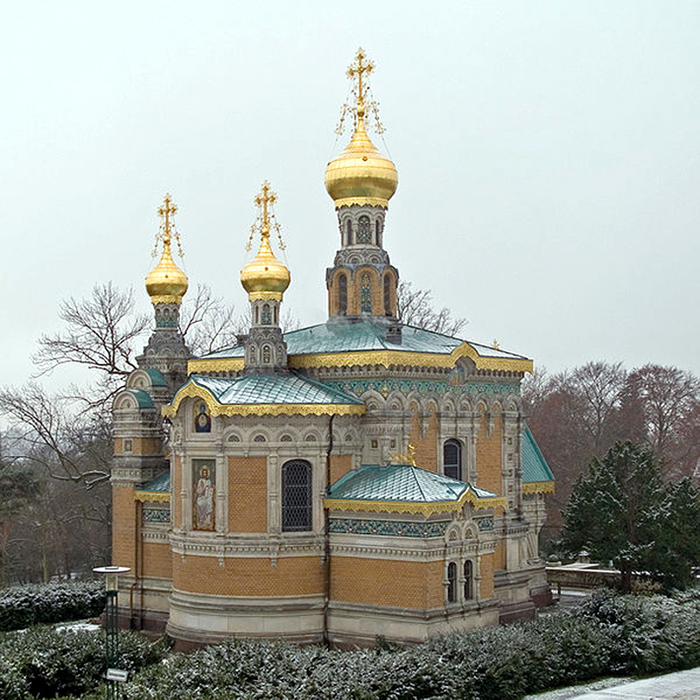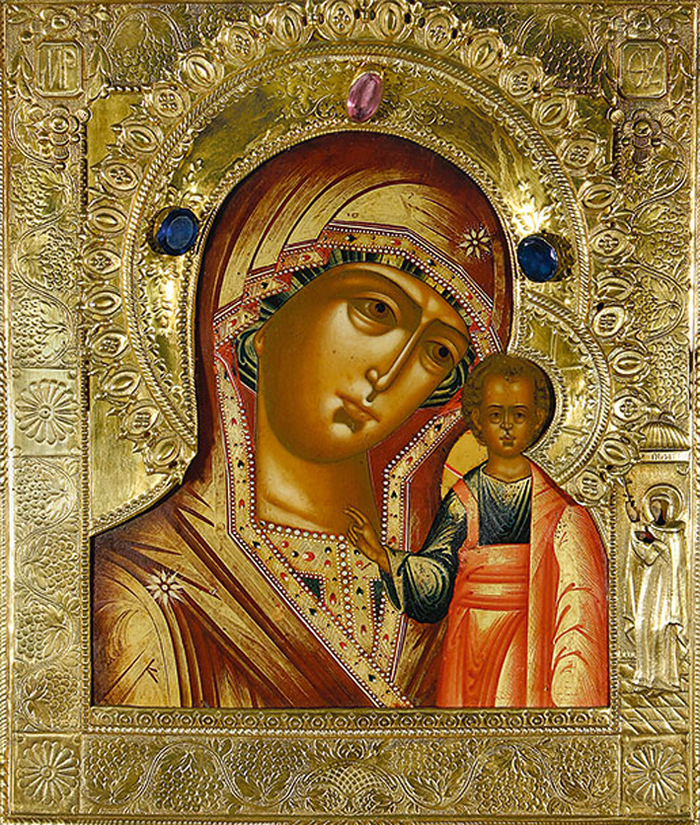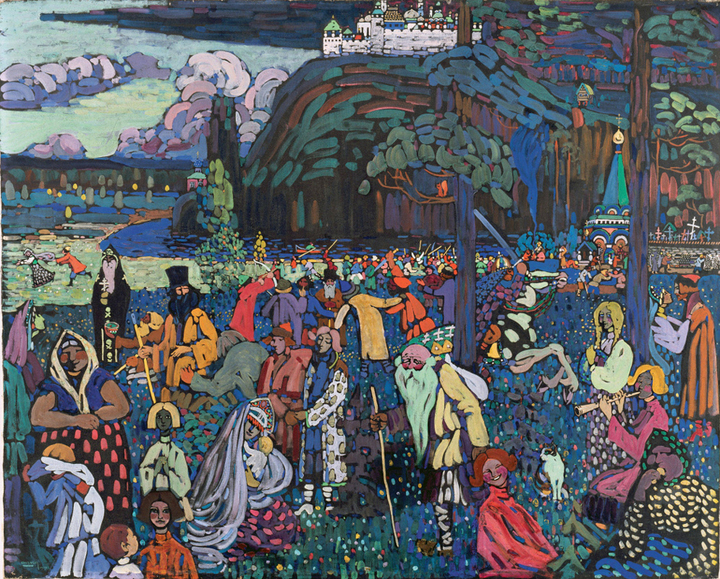The country in which we live is diverse and amazing. It allows you to get to know big metropolises and cozy fabulous places with ancient architecture. The natural beauty of Germany is combined with the well-known well-groomed and clean landscape available to any tourist.
But for those who are not indifferent to the cultural heritage of their ancestors, visits to the treasuries of world culture, where the works of our compatriots are kept, are of particular interest.
Poppies of churches
Among the many repositories of beauty near the famous museum embankment of Frankfurt am Main, the House of the German Order stands alone. Since 1990, it has housed a collection of Orthodox icons. More than 1000 copies, mainly of Russian masters, were collected and received as a gift from Soviet statesmen by the local doctor Jorgen Schmidt-Vogt. At the end of the 80s, the doctor gave his unique collection to the city.

Church of St. Mary Magdalene in Darmstadt. Photo ru.wikipedia.org.
In German Hesse there are several memorial churches that stand on Russian soil. So, an undoubted masterpiece, which has been crowning the top of the Wiesbaden mountain Neroberg for 165 years, is the burial vault of the young niece of Alexander I and Nicholas I, Princess Elisabeth von Nassau. The Russian autocrats were generous, repeatedly arriving in the most beautiful corners of Germany with their spouses who visited their native places. Here plots of land were acquired and Orthodox churches of extraordinary beauty were erected, which until 1933 remained the property of Russia. Russian architect Leonty Benois built in Darmstadt, by order of Nicholas II, the amazing Church of St. Mary Magdalene in honor of his wife, Alice. A prayer building for the Orthodox denomination in the beautiful park of the spa town of Bad Homburg looks like a miniature palace from a fairy tale. There is a Russian church that belonged to Nicholas II in Bad Nauheim. These temples today are worthy not only of contemplation, but also of worship.
More recently, at the end of the 20th century, the Church of St. Stephen in Mainz became famous. Rebuilt in 1290-1338, acquiring Gothic forms, the church became famous thanks to a native of Russia, the aged genius Marc Chagall. France entrusted him to paint the ceiling of their national pride – the Parisian Grand Opera. Therefore, the artist, who had reached 89 years old by the beginning of his work, was ordered to stained glass windows for the decoration of the windows of a German building destroyed during the Second World War. Thus, the priest of this church, Klaus Mayer, made a conciliatory gesture that sealed the union of the Jew and the Catholic Church. Especially valuable in that Chagall refused part of the due fee.

Icon of Our Lady of Kazan in the Frankfurt Museum. Russia, 18th century. From the collection of J. Schmidt-Vogt. Photo: Ikonenmuseum Frankfurt.
The master worked on a grand order until the end of his days, from 1976 to 1985. He made nine main stained-glass windows, the rest were completed by his colleague and student Charles Marc. Anyone who has ever visited the Church of St. Stephen will never forget the heavenly blue of these windows, which have almost fifty shades of the same color. Germany aroused conflicting feelings in Marc Chagall. On the one hand, it was in Berlin, in the gallery of the “Storm” magazine, that his first personal exhibition was held. Here, eight years later, in 1922, an album of illustrations for memoirs was published, and then the book “My Life” itself, translated into many languages of the world. She was able to reach the Russian reader only in 1994. At home, recognition of merits came to the artist only after his death. During his lifetime, Chagall was greatly hurt by the message that in Germany, by order of Goering, his canvases were burned, although by this time, by 1933, he was already widely known throughout the world.
Russian trace
The same test befell another Russian by birth, but who became a beloved and honored artist in the West, Wassily Kandinsky. Throughout the 19th century, cultural ties between Germany and Russia grew stronger and developed. Having set the goal of becoming a real master, Vasily Vasilievich travels to Germany at a mature age. Here he studies a lot, learns the basics of classical painting. In 1900 he received a diploma from the Academy of Fine Sciences in Munich.
Having become a citizen of Germany in 1928, having glorified not only his name with discoveries in the field of painting, but also the country that sheltered him, he was forced to flee when the Nazis came to power. His works were obstructed as “degenerate art”, the Bauhaus school of painting, his favorite brainchild, the place of his teaching and scientific development, was closed.
The leader of the avant-garde of the first half of the 20th century spent the rest of his life in France, where he died in 1944. But his paintings, illustrations, theoretical developments have replenished the treasury of world art. The Munich villa Lenbachhaus, now home to the municipal art gallery, houses the world’s largest collection of works by abstract artists, the Blue Horseman group. But it was Wassily Kandinsky in October 1911, together with his colleague Franz Mark, founded this group in Munich, putting forward the concept of a new direction in art.

Wassily Kandinsky. Colorful life. 1907, Lenbachhaus, Munich. Photo: de.wikipedia.org.
… At that time, his works were highly valued along with the canvases of Picasso, Matisse, Cezanne. The Blue Rider held serious exhibitions where one could get acquainted with the masterpieces of the avant-garde. From time to time, the artist returned to Russia. Where his roots were, Kandinsky wanted to live and work. He became a professor at Moscow State University, created the Institute of Artistic Culture. As a real ascetic, he arranged exhibitions of colleagues, contributed to the opening of 22 museums throughout Soviet Russia. But abstractionism did not find support in the country, then a different style, socialist realism, was born.
Wassily Kandinsky leaves with his young wife for Berlin. Here he found understanding and recognition. Disciples and followers were not long in coming. And today in many German administrative institutions, in bureaus and private art galleries, you can see reproductions of paintings from this period. Bright color, bizarre lines, unusual shapes ─ a new artistic style attracts the viewer’s attention. In his book On Spiritual Art, the great avant-garde artist writes a lot about the freedom of the artist when working with forms, explains his own language of paintings. The ordinary viewer can always compare his understanding of the paintings with the interpretation of the master, having visited the Munich art gallery.
The Städel Museum in Frankfurt exhibits not only outstanding works of European painting from the 14th century onwards. Here you can also see paintings by Wassily Kandinsky.
Talking about the exhibits is a useless and thankless task. Come to museums and art galleries. Perhaps you will discover a new world that is not a reflection of reality, but clarifies the worldview and skill of the people of Russian culture in the first half of the last century …
Elena GRINBERG.
Germany says this:
Germany: More young people are contracting Covid-19
A glimmer of hope for hotels and restaurateurs in Bavaria
Germany: Lufthansa loses customer confidence
Warning: A New Kind of Internet Flight Cancellation Scam